Abstract
In an Internet of Things (IoT) environment, a large volume of potentially confidential data might be leaked from sensors installed everywhere. To ensure the authenticity of such sensitive data, it is important to initially verify the source of data and its identity. Practically, IoT device identification is the primary step toward a secure IoT system. An appropriate device identification approach can counteract malicious activities such as sending false data that trigger irreparable security issues in vital or emergency situations. Recent research indicates that primary identity metrics such as Internet Protocol (IP) or Media Access Control (MAC) addresses are insufficient due to their instability or easy accessibility. Thus, to identify an IoT device, analysis of the header information of packets by the sensors is of imperative consideration. This paper proposes a combination of sensor measurement and statistical feature sets in addition to a header feature set using a classification-based device identification framework. Various machine Learning algorithms have been adopted to identify different combinations of these feature sets to provide enhanced security in IoT devices. The proposed method has been evaluated through normal and under-attack circumstances by collecting real-time data from IoT devices connected in a lab setting to show the system robustness.
1. Introduction
We are witnessing the dawn of the Internet of Things (IoT) era, providing interconnection between the physical and the digital worlds with a remarkable impact on every aspect of our lives. Correspondingly, IoT has been paving its way in multiple sectors, recently including household and industrial solutions. The number of IoT devices can be predicted to reach up to 500 devices per household by 2022 [1]. In IoT-based smart city environments, an enormous number of physical devices are employed throughout the city, which are highly accessible and consequently, making their physical security of paramount importance. Such issues related to weak physical security as easy device disassembling, access of device data by malicious means, and removable storage media are considered major security threats [2]. Henceforth, despite the various benefits imparted by them in terms of flexibility and usability, these also entail a multitude of security concerns and attacks [3]. A foremost consideration in attack prevention for IoT devices is isolating such devices with restrictive communications to other devices through a gateway. Apparently, instead of device isolation, proper IoT device identification is a better approach for network administration considering security risks [4].
Additionally, the provision of a secure communication channel is another challenge apart from physical security. Presently, secure communication is provided by public and private key pairs or certificate installation on these devices, which helps provide the identity of the device. Again, there are limitations to using these certificates; for instance, if these certificates are accessed by an unauthorized entity, it will allow identity theft, allowing the transmission of false data to other devices in the network. It will impact the decision-making process because decisions are usually made on the aggregated data from different devices and a single falsification of data will affect the entire system. As a countermeasure, hardware-based and software-based approaches can be applied. The Root of Trust (RoT) is an example of hardware-based solutions that can be equipped by using either hardware like a chip called the Trusted Platform Module (TPM) or using software like Trusted Execution Environment (TEE). Using RoT, which is embedded on an IoT device, the authenticity of other certificates can be verified by the root, which is chained to those certificates [5].
Apart from hardware-based approaches to countermeasure these types of identity thefts, the system should be capable enough to identify these threats. The identity claimed by the user is validated and proved by employing authentication techniques which include certificates, local user/password setting, or OAuth server connection (as shown in client-side identification of Figure 1). This problem has been resolved by using Facebook authentication with OAuth2 and an Access Control List (ACL) approach, where access rules are specified using a tree-based information structure [6].
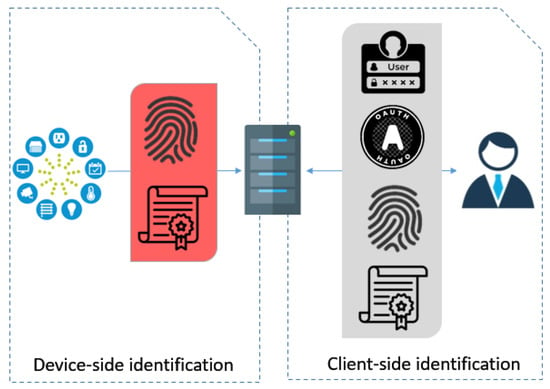
Figure 1.
Identification in Internet of Things (IoT).
In contrast, there are very few options for verifying the device identity as shown in device-side identification of Figure 1. The main challenge on the device-side is to authenticate the origin of the received messages on the server to detect identity thefts. One solution is using a certificate, which can easily be spoofed. Device fingerprinting can be considered a more optimal solution in which the process of identification of connected devices can be automated by network administrators [7]. Similar to fingerprinting, device profiling can be an approach for continuous device identification by monitoring behavioral features.
Paper Contribution: This work addresses the challenge of IoT device identification within a network by analyzing and classifying network traffic data for device identification from arriving packets with high accuracy by taking machine learning (ML) approaches. We solve this problem by presenting an identification approach based on sensor measurements, statistics, and header information for device behavior or device profiling by monitoring the data packets coming from smart devices to protect the server from receiving and spreading false data. Each device’s behavior is defined by its features, which are characterized by seven profiling models specified in the proposed framework. We adopt ML methods to learn unique features of each IoT device without expert supervision and evaluate them using network performance and algorithms’ accuracy. For proof-of-concept, we implement a demonstrator system for the IoT system comprising of temperature and humidity sensors integrated through open standards called Open Messaging Interface (O-MI) and Open Data Format (O-DF). The present paper is an extended version of our paper, presented at the INDIN conference [8]. This paper significantly expands the feature sets and develops realistic results by running a real use-case, collecting real data, and evaluating the system through various attack scenarios.
2. Literature Review
As there is a need for multiple users and devices to authenticate each other using trustable services, it is imperative that identity authentication be managed in IoT networks. The device identification idea for handling data privacy was first coined by Sarma and Girao [9] in 2009, however, most of the identity management systems based on Service Oriented Architecture (SOA) in IoT such as Shibboleth, Card-Space, and Liberty Alliance rarely considered the identity of devices in the framework [10]. To identify the device identity, the security module can either employ its identity or its specific features. Recently, various types of features in communication networks have been adopted by researchers for device identifications. The most common features lately applied could be location based on Global Positioning System (GPS) and Wi-Fi [11,12], the familiarity of devices derived from Bluetooth, time [12], identity (MAC—Media Access Control, IP—Internet Protocol, or RFID—Radio-Frequency Identification tag) [12], unique hardware-specific characteristics such as clock skew [13,14,15], device fingerprinting using MAC and properties of packets received from a device such as address and port of client and server [16], inter-arrival time [17], padding, packet size, and destination IP counter [18]. During attack detection, real-time and environmental factors also need to be considered to avoid false alarms [19].
Header information has been adopted extensively for device identification methods in the literature. A device identification technique has been proposed for the identification of the device model and type based on header information’s similarity calculation and this method is built for factory-used devices and network cameras by relying on general communication information [20]. Another method employs device fingerprinting for authentication and identification purposes by training an ML method based on extracted features from the network traffic for the detection of similar types of devices [21]. An automated classification system was also developed for device characteristics known as System Identifier (SysID) [4]. They applied Genetic Algorithms (GA) to distinguish the most unique features and various ML methods to classify the device type. ML algorithms were used in another approach on network traffic data for device identification of the devices connected in an IoT network [22]. The labeled data were employed for training and validating the classifier where labeled data were collected from nine unique IoT devices, smartphones, and personal computers. A multi-stage meta classifier was trained using supervised learning in the first stage to distinguish the IoT and non-IoT devices generating traffic and in the second stage, a unique class has been associated with each IoT device.
In some use-cases, the non-white list (not allowed to be used within any premises of organization) devices for trustworthy IoT device types need to be detected. For this purpose, a supervised ML algorithm, Random Forest (RF) was adopted to train extracted features from network traffic data with an objective to correctly identify the types of IoT devices from the white list [23]. A multi-stage classification algorithm was developed based on the network activity, demonstrating its ability to identify particular IoT devices [24]. A device identification approach was proposed where packet sequences from high-level network-flow traffic data were analyzed using supervised ML techniques to extract distinct flow-based features to create device fingerprinting [25]. The proposed approach was able to automatically identify device types in the white list and the individual device instances in the IoT network. Furthermore, a system security model was also designed to enable rules enforcement to constrain IoT device communications according to their privileges. This helps in suspicious device identification with abnormal behavior restricting their communication to avoid further monitoring. A similar ML approach based on sent and received packet streams was proposed to recognize connected IoT device types in an experimental smart home network and the designed model helps describe IoT device network behaviors [26]. Another system named AuDI (Autonomous Device Identification) [27] was proposed by analyzing the device-related network communications to identify the device type in an IoT network traffic. An unsupervised learning algorithm was used for modeling periodic IoT devices’ communication traffic for identification. Hence, after the initial learning phase, AuDI’s operation is fully automatic for the identification of previously unfamiliar devices and device types in any operational mode or device lifecycle stage.
Table 1 represents a summary of state-of-the-art from various perspectives. Most of the current identification methods focus on identifying the types of IoT devices from the predefined list of legitimate devices while our method verifies identities of the devices by making profiling models for each of them. The proposed method in this paper is considered a traffic analysis method with certain differences. Since payloads mostly are encrypted in traffic analysis, payload information is not operational in constructing the fingerprinting. However, in our implementation, due to the new messaging standards (O-MI/O-DF), the unencrypted payload data are accessible on the server. Therefore, we adopt the payload data for device identification alongside header information and generated statistical features. The idea of using payload data or sensor measurements for device identification is initially proposed by [8]. This identification framework employs only payload data and some extracted statistical features from a public dataset without taking into consideration any attack scenarios. However, in the current paper, by collecting data from a real use-case, header information can also be extracted to be combined with payload data, which creates a variety set of diverse features. In addition, the paper accomplishes the experimental results by evaluating the classification results under various attack situations.

Table 1.
Comparison of the proposed work with state-of-the-art techniques.
3. Device Identification Framework
Figure 2 presents a high-level overview of the framework, which makes device identity decisions by performing automatic classification of IoT devices. Such classification works based on sensor measurements, traffic data, and a classifier model. This system overall encompasses four layers: data collection, dimension extraction, analysis engine, and security management. The system also includes two key modules, namely, Model Management and Security Management. Model Management will be responsible for detecting the most adequate features and investigating their weight or importance through ML methods. Once the dimensions have been extracted and the ML model of the current device is identified, Security Management decides on the security options, whether it is authenticated or not, and provides the enforcement support. Additionally, two databases (DBs) are also accessible to manage the data. The first DB, Sensor and Header DB consists of the sensor measurements, header information, and dimension names. Once the required dimensions have been loaded from the first DB, the value of each dimension will be elicited from the observation and the learned model will be stored in Classifier DB.

Figure 2.
IoT device identification framework.
This is a data-driven framework obtained from sensor devices via GPS (Global Positioning System), Wi-Fi, and Bluetooth at the beginning of the Data Collection layer. Simultaneously, a packet analyzer such as Pyshark captures the traffic features extracted from packet headers. Then, the Features Extraction module applies all the features for calculating the feature vector to describe the present observation based on the value of the extracted features. Subsequently, a data query will be sent to Sensor and Header DB by the Data Preparation module for finding the necessary sensor and header information. During the device’s learning phase, the sensor data and extracted features are trained to build the model for the device using a training and testing set. The Classifier DB stores the trained model from the Classification Engine.
Once the learning phase is completed, it is time for the prediction phase (red lines in Figure 2), as the next step in model processing. After extracting the features from the new input, the features and the classifier models loaded from the Classifier DB will be employed by the Classification Engine to classify new observations. As the classification result is prepared, the engine will assign a security level (e.g., binary value) to the classifier and forward it to the Security Management layer, which considers the security level during the verification of device identity. The Identification module verifies the identity and labels the available feature set of current observations as malicious or legitimate. The feature set in the last module can be composed of header features, sensor measurement, some statistical features, or a combination of them all.
4. Enforcement
The implementation details including system methodology and steps, model creation and selection, and feature extraction are discussed as follows.
4.1. Methodology
To describe the device identification framework, Figure 3 depicts a workflow of implementation steps. As seen in the figure, the first step in implementing the device identification framework is to set up the environmental modules including the O-MI node, security modules on top of the O-MI node, IoT gateways such as Raspberry Pi (RPi) and Electronic Stability Program (ESP), and sensors connected to IoT gateways. From thereon, all the modules will be operated over the O-MI server, which is implemented on a virtual machine at Aalto University. All these modules generate a concrete security module that is easy to plug-in on various servers, due to its modularity. On the other hand, running all the security modules in a single place convert it to a new product that can be reused on any other smart environment with minor patches.
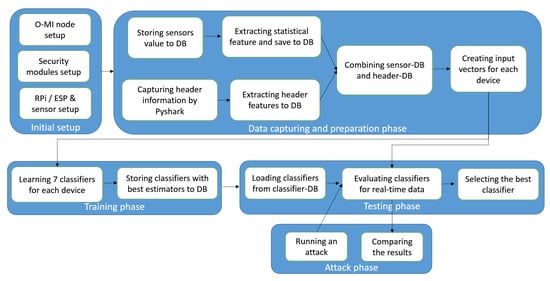
Figure 3.
Implementation steps.
Once all the required modules are running, in the Data capturing and preparation step, the sensor measurements can be stored in the sensor-DB on the O-MI server. Simultaneously, header information related to HTTP messages arriving from the sensors can be captured and extracted to the header-DB. Python has been selected as the core programming language of this phase and the remaining phases. Thus, to allow Python packet capturing and packet parsing, a Python wrapper called Pyshark has been employed which uses Wireshark dissectors (or tshark).
Alongside the sensor measurements and header features, few time-based features are also calculated based on the date-time attribute measured by sensors. Such features generate the third category called statistical features, which will be stored in sensor-DB. Therefore, for each sensor data sent to the server, three categories of features (sensor measurements, header features, and statistical features) can be incorporated in seven combinations as input vectors for the Training phase. Accordingly, seven classifiers are defined for each gateway device with their best estimators. These classifiers will be stored in classifier-DB and later during the Testing phase, they will be fetched from the same DB. Once the classifiers are loaded in the Testing phase, seven input vectors similar to the training vector but containing testing data are created and the real-time data are evaluated with previously learned classifiers. The best classifier is selected based on the evaluation results. Finally, to investigate the effect of attacks on the evaluation results and if the best classifier can efficiently find the attack, some attacks will be implemented and the performance results will be compared.
4.2. Model Creation and Selection
Since it is a classification problem, first we need to collect data for both classes (normal and abnormal) and train the model according to these data using ML algorithms, which are chosen based on the data linearity or non-linearity. Then, we can use this model to classify the new data. We use classification since it is more accurate than unsupervised models. For this purpose, we make a unique classifier model for each device that serves as the device profile. We employ the One-Vs-Rest classifier also called the One-Vs-All classifier, which is a multi-class classifier training one classifier per class. As a result, N classifiers will be created for N classes [25]. To achieve this, any (i.e., a sequence of packets) captured on the server will be labeled either as 1 or 0 in n profiles (n = number of devices). For instance, to create the profile for (), the label for equals 1 if such flow arrives from device i and equals 0 if it arrives from other devices . In other words, will be labeled as 1 in , and as 0 in , as seen in Equation (1). As a result, n device profiles are available for learning the model. Then after finishing the device profiling, the features in profiles (including sensor measurements, statistical features, and header information) will be divided to make seven possible models as inputs to ML algorithms. The models are Statistic-only, Measurement-only, Header-only, Statistic-Measurement, Statistic-Header, Measurement-Header, and Statistic-Measurement-Header or Aggregation.
Once the models are created, the ML algorithm will acquire the models for each device and learn or load the classifier whether it is in the training or testing phase. To implement the ML algorithms, Scikit-learn Library parameters are applied with their best estimators.
4.3. Feature Extraction
In this paper, considering six sensor sets and IoT gateways, the real-time sensor data and their header packet information are collected on the virtual machine and stored in separate datasets including header-DB and sensor-DB. Packet headers were captured using Pyshark, and the nominated header features have been stored in header-DB. It is imperative that the verification of continuous identity considers the selected features. Once the sensor data are received by the server, the data and their behaviors are verified by comparison with the previous values present in the feature database.
All binary or integer features with zero variance such as IP version (), IP header length (), IP protocol (), IP header checksum () were removed from header-DB. Besides, to avoid redundancy, we keep only one feature among highly correlated features. For instance, the Sequence number is stored between the Acknowledgment number and the Sequence number or the Next sequence number is chosen between the Segment length and the Next sequence number. Besides, sensor-DB consists of two sensor measurements (Temperature and humidity) and two statistical features (flow duration, inter-arrival time). The inter-arrival time is calculated for each packet according to the time interval between two consecutive packets (current and previous packets). Table 2 represents the list of features with their importance rate calculated through the RF algorithm. Features with a higher importance rate have a more significant impact on the algorithm results. As seen in the table, the sensor measurements and statistical features have a much higher impact compared to header-based features.

Table 2.
List of features.
5. Adversary Model
As IoT devices are spreading around the world, cyber-attacks are becoming more sophisticated in multiple stages by coordinating various attacks from different places, thus requiring more complex defense mechanisms and vulnerability assessments. To properly assess the vulnerabilities, the network requires to face a simulated attack. In other words, a real synthetic attack scenario will occur in the network so that the potential breaches or vulnerabilities and the related defense mechanisms can be identified [28]. In this investigation of two general attack categories called physical attack and remote access attack, we simulate two attacks from these categories including object emulation attack and Botnet attack. However, only one set of results is presented in the paper, since both attacks have the same effect on the system, and as a result, they yield similar evaluation results. “we introduce two types of common attack scenarios in IoT environments, which can be detected by our device identification approach. We want to show that our model not only identifies the device identity but also can detect the attacks originating from the identity theft.”
5.1. Our Attack Model
5.1.1. Physical Attack
A physical attack or object emulation attack [19] occurs when an extra device of the same identity as an authorized device is attached to the IoT network where this identity is used for falsification of the messages to convey an illusion as if the actual legitimate user is sending these messages. The device certificates are physically accessed from an authorized device by an attacker for installation on any other IoT device, by which the malicious device is granted access to send wrong data to the server (see the malicious device in Figure 4). These false data can be used by an attacker to trigger a false alarm (e.g., fire alarm) inducing a disaster. Hence, this type of physical security generally possesses two possible solutions [29]: network layer security control or barrier placing around the network. As barriers in open environments and large spaces, such as public places and smart campuses are impractical, the exploration of the network layer security control is a more feasible solution.
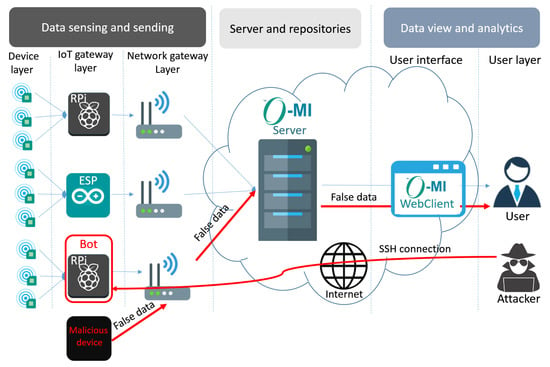
Figure 4.
Object emulation attack and Botnet attack model in IoT.
5.1.2. Remote Access Attack
Botnet attack is the most popular remote access attack. The attacker remotely connects to an RPi (bot) through a Secure Shell (SSH) connection simply by knowing its login credential. Then, using this bot, the attacker can control the data sending process from the sensor to the server. From now on, whenever the user requests temperature and humidity data, the bot can forge the data passing the RPi. For instance, if the sensor measurement is 24 for temperature and 26 for humidity, the bot modifies the data to 10 and 10. Eventually, by receiving the false temperature and humidity, the user might turn on the heater or humidifier and triggers a critical incident in environments such as hospitals demanding careful consideration. Figure 4 displays the attack scenario.
6. Evaluation
In this section, initially, the testing scenario and performance metrics will be defined. Then, according to the introduced metrics, the classification results will be analyzed in various circumstances: the normal implementation of the network with no attack and the implementation while the attack running on the network.
6.1. Scenario Description
To evaluate our approach, a prototype system in a real environment (i.e., an office) has been established as shown in Figure 5. It generally contains six sensors, six IoT gateways, six wireless routers, a virtual server, and the security module running on the server. In such a prototype, two different temperature and humidity sensors including 1-Wire and SHT-20 are respectively connected to two IoT gateways Raspberry Pi 3 (RPi3) and ESP8266, which are all installed in an office in the Aalto ASIA (Adaptive Systems of Intelligent Agents) Lab. By connecting to the Internet through various wireless routers, IoT gateways forward the sensors’ data in tree-based O-DF ontology to the O-MI server. In other words, a wrapper is running over the IoT gateway which reads the sensor value, translates it to the O-DF, makes an O-MI Write request, and finally sends an HTTP POST request. The O-MI server then manages the device identification via running the security service.
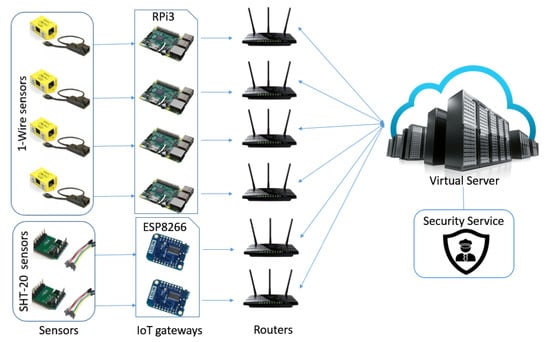
Figure 5.
Experimental setup for data collection.
Based upon three categories of features (measurement-based, header-based, and statistical), seven profiling methods are established: Measurement-only, Header-only, Statistic-only, Measurement-Header, Measurement-Statistic, Header-Statistic, and Aggregation. The Measurement-only, Header-only, and Statistic-only methods include only the sensor measurements (Temperature and Humidity), header features (first set of features in Table 2), and statistical features (flow duration, inter-arrival time), respectively. In the same vein, the Measurement-Header, Measurement-Statistic, and Header-Statistic methods contain a combination of two sets of features as defined in their names. Finally, the Aggregation method combines all three sets of features into one model.
6.2. Performance Metrics
Various performance metrics have been used for the evaluation of the efficiency of the proposed system, which are described below.
6.2.1. Confusion Matrix
The exactness and reliability of a system are calculated through a confusion matrix which is also termed an error-matrix. This matrix promotes a clear idea of the system performance by analyzing the misclassification rate and accuracy.
- True Positive (TP): When the predicted and actual classes are identically at true class (1).
- True Negative (TN): When an element is predicted to be in False class (0) and it truly belongs in false class (0).
- False Positive (FP): When the system predicts an element to be in true class (1) but in actual it does not.
- False Negative (FN): When the system predicts that an element does not belong to a false class (0) but in actual it does.
6.2.2. Accuracy
Accuracy refers to the total number of correct classifications performed by the network out of the total number of classifications made. As shown in Equation (2), accuracy is the rate of true predictions by all the true and false predictions combined.
6.2.3. Recall or Sensitivity
Recall is the rate of accurately predicted positives to genuine positives. Recall provides us with an idea about a model’s performance proportionate to false negatives.
6.2.4. Precision
Precision is the rate of accurately predicted positives to all the predicted positives. Precision is about predicting frames correctly, whereas Recall is about predicting all the positive frames correctly [30]. So, to minimize false negatives, we must focus on enhancing Recall as high as possible with a decent and acceptable Precision value. The values of both Precision and Recall can be monitored by a single value performance metric called the F1-score.
6.2.5. F-Score
To consider the role of both precision and recall, the F1-score is computed. As presented in Equation (5), the F1-score is simply the harmonic mean of precision and recall. In the case of unbalanced class distribution in the dataset, the F1-score is a more optimal evaluation metric than accuracy. A low value of the F1 score indicates a problem when either Precision or Recall has a low value. In that case, the F1-score is closer to the smaller value than the bigger value out of these two.
6.3. Classification Results under Normal Situation
During the training phase, data are collected for 25 h in Comma-Separated Values (CSV) format in which columns represent the nominated features and each row includes a list of features related to one arriving packet. Then, the seven profiling systems defined in Section 4.2, will be trained through three ML methods, namely, RF, Support Vector Machine (SVM), and Logistic Regression (LR). Henceforth, during the testing phase, once the data are collected for the next 5 h in CSV data format, the trained models will be adopted to verify the device identity by measuring the performance metrics. This process continuously occurs every five hours. Due to data collection being performed in 25 and 5 h, the ratio between the training and testing set will be 80–20, which is the most common proportion of training and testing data. The average values of performance metrics are calculated for six classifiers corresponding to each IoT device. The experimental results for three ML methods are represented in Table 3, Table 4, Table 5, Table 6, Table 7, Table 8 and Table 9.

Table 3.
Classification performance for aggregation.

Table 4.
Classification performance for Measurement_Header.

Table 5.
Classification performance for Measurement_statistic.

Table 6.
Classification performance for Header_statistic

Table 7.
Classification performance for Measurement_only.

Table 8.
Classification performance for Header_only.

Table 9.
Classification performance for Statistic_only.
Considering all the tables, it can be determined that SVM has the highest accuracy and F1-score compared to other ML methods in most of the profiling models. Moreover, although both SVM and LR generally perform fast, SVM has the fastest building time (in seconds) in our case scenario. Hence, we nominate SVM for attack analysis in the next step. Our data have two fundamental properties: (I) they include a relatively small level of sparsity, and (II) classes are not linearly separable. SVM can nicely handle binary classification tasks where the classes are not linearly separable while LR is unable to cope with such problems well. We think the reason why SVM outperforms RF is because of the first property of the data above. Although the sparsity level is not large, it can still negatively affect the performance of RF. Furthermore, SVM is intrinsically suitable for binary classification tasks, same as our classification task, while RF is suitable mostly for multi-class classification tasks. On the other hand, regarding the profiling system, the Measurement-only model reports the best results for all the ML methods. The next best models are measurement-statistic and measurement-header. Therefore, we can conclude that models including measurement features generally perform better compared to the rest of the profiling models.
6.4. Classification Results under Attack Situation
This section evaluates performance results through the attack scenario where the SVM method is employed for device identification. In other words, the best classifiers in the previous analysis under normal situation is employed in this section to detect attacks and the effect of attacks on the results is evaluated based on the FP rate. As a result, we can analyze whether the best profiling models and features in a normal situation are also able to efficiently detect the attack or other models and sets of features operate better under the attack situation. Two main attack scenarios are introduced. In the first scenario (Scenario 1), the attacker forges both sensor measurements including temperature and humidity while in the second scenario (Scenario 2), only one of them (temperature) will be modified by the attacker through one infected IoT gateway. The attacker could also send the forged data in different inter-arrival times (30, 50, 70, and 100), in which 100 s is the same as the original inter-arrival time of the legitimate device. Since the attack should be detected at the earliest opportunity, we evaluate the model performance over each scenario for every hour.
A FP rate is selected to analyze the performance of various profiling methods during attacks. The lower FP rate represents a higher performance for the profiling model. As seen in Figure 6 and Figure 7, the profiling methods with measurement features (i.e., Measurement-header and Measurement-statistics) have a minimum FP rate explaining that these can be employed for higher performance. In other words, the best profiling methods under normal circumstances can also make the best performance results during the attack scenario. It can also be explained with the help of Table 2, where measurement features have the highest importance but when they are combined with header features (which have the next highest feature importance) they even perform better, which is clear from the results presented in Figure 6 and Figure 7.
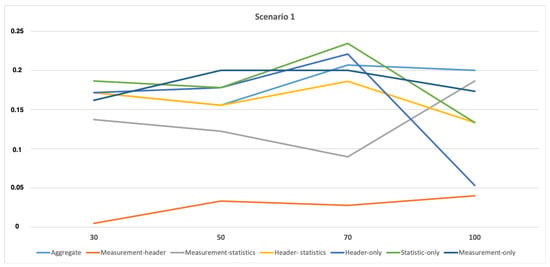
Figure 6.
False Positive (FP) rate for attack scenario 1 for all the profiling models.
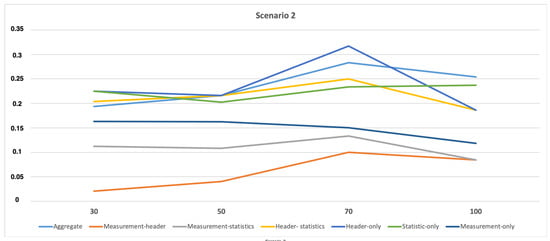
Figure 7.
FP rate for attack scenario 2 for all the profiling models.
As seen in Figure 8, the measurement-header has the lowest FP rate for both Scenario 1 and Scenario 2. At the same time, measurement-statistic has a slightly higher FP rate and finally measurement-only has the highest while comparing these three profiling methods. Hence, when measurement features are combined with other features especially header features, they perform on a higher level.
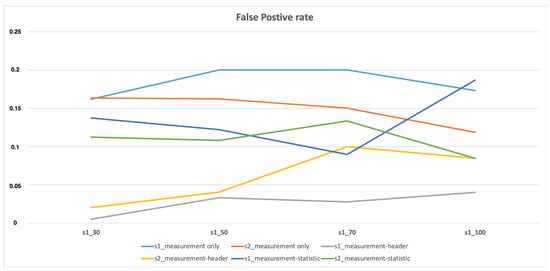
Figure 8.
FP rate for attack scenario 1 (s1) and scenario 2 (s2).
Since measurement features have a more profound effect on the results, they are selected and the performance metrics for the measurement-only and measurement-header are calculated using the SVM classifier and presented in Table 10. The values are calculated for the different inter-arrival times for both the attack scenarios. Further, the measurement header performs better than measurement only for all the inter-arrival times.

Table 10.
Support Vector Machine (SVM) results for measurement-only and measurement-header during attack scenarios.
7. Conclusions and Future Work
After proposing an IoT device identification in our previous work, and presenting two profiling methods, we learned that this framework is fixable enough to run more variety of profiling methods. Accordingly, seven profiling models have been defined. First, three methods are based on a single data category (the sensor measurement-only, header-only, and the statistic-only). Second, three methods are based on double data categories (measurement-header, measurement-statistic, and header-statistic). Finally, the last type is the aggregation of all features provided by the first three methods. The performance of these models is evaluated by implementing a real IoT use-case. Our results show a significant accuracy improvement in the measurement-based models, especially the measurement-header model. Future work ought to be dedicated to increase the type and number of IoT devices and to collect real-time network data for a longer period of time. We also plan to include behavioral features for device identification.
Author Contributions
Conceptualization, N.Y.; methodology, N.Y.; software, N.Y.; validation, N.Y.; formal analysis, N.Y.; investigation, N.Y.; resources, N.Y.; data curation, N.Y.; writing—original draft preparation, N.Y. and A.M.; writing—review and editing, N.Y.; visualization, N.Y. and A.M.; supervision, K.F. and A.M.; funding acquisition, K.F. All authors have read and agreed to the published version of the manuscript.
Funding
This research was funded by the European Union’s Horizon 2020 research and innovation program (grant 688203), H2020 project FINEST TWINS (grant No. 856602), and Academy of Finland (Open Messaging Interface; grant 296096).
Institutional Review Board Statement
Not applicable.
Informed Consent Statement
Not applicable.
Data Availability Statement
The data used to generate the plots and figures can be accessed by contacting the author at narges.yousefnezhad@aalto.fi.
Acknowledgments
The research leading to this publication is supported by the European Union’s Horizon 2020 research and innovation program (grant 688203), H2020 project FINEST TWINS (grant No. 856602), and Academy of Finland (Open Messaging Interface; grant 296096).
Conflicts of Interest
The authors declare no conflict of interest.
References
- Gratner Newsroom. 2015. Available online: https://gartner.com/en/newsroom/id/283971 (accessed on 4 June 2020).
- Bertino, E.; Islam, N. Botnets and internet of things security. Computer 2017, 50, 76–79. [Google Scholar] [CrossRef]
- Shah, T.; Venkatesan, S. Authentication of IoT device and IoT server using secure vaults. In Proceedings of the 2018 17th IEEE International Conference On Trust, Security And Privacy In Computing And Communications/12th IEEE International Conference On Big Data Science And Engineering (TrustCom/BigDataSE), New York, NY, USA, 31 July–3 August 2018; pp. 819–824. [Google Scholar]
- Aksoy, A.; Gunes, M.H. Automated IoT Device Identification using Network Traffic. In Proceedings of the 2019 IEEE International Conference on Communications, ICC 2019, Shanghai, China, 20–24 May 2019; pp. 1–7. [Google Scholar] [CrossRef]
- Raval, M.; Sunkireddy, R. Hardware Root of Trust on IoT Gateway. 2019. Available online: https://www.techdesignforums.com/practice/technique/hardware-roots-of-trust-for-iot-security/ (accessed on 8 April 2021).
- Yousefnezhad, N.; Filippov, R.; Javed, A.; Buda, A.; Madhikermi, M.; Främling, K. Authentication and Access Control for Open Messaging Interface Standard. In Proceedings of the 14th EAI International Conference on Mobile and Ubiquitous Systems: Computing, Networking and Services, Melbourne, Australia, 7–10 November 2017; Gu, T., Kotagiri, R., Liu, H., Eds.; ACM: New York, NY, USA, 2017; pp. 20–27. [Google Scholar] [CrossRef]
- Li, B.; Gunes, M.H.; Bebis, G.; Springer, J. A supervised machine learning approach to classify host roles on line using sflow. In Proceedings of the First Edition Workshop on High Performance and Programmable Networking, New York, NY, USA, 18 June 2013; pp. 53–60. [Google Scholar]
- Yousefnezhad, N.; Madhikermi, M.; Främling, K. MeDI: Measurement-based Device Identification Framework for Internet of Things. In Proceedings of the 16th IEEE International Conference on Industrial Informatics, INDIN 2018, Porto, Portugal, 18–20 July 2018; pp. 95–100. [Google Scholar] [CrossRef]
- Sarma, A.C.; Girão, J. Identities in the future internet of things. Wirel. Pers. Commun. 2009, 49, 353–363. [Google Scholar] [CrossRef]
- Mahalle, P.; Babar, S.; Prasad, N.R.; Prasad, R. Identity management framework towards internet of things (IoT): Roadmap and key challenges. In International Conference on Network Security and Applications; Springer: Berlin/Heidelberg, Germany, 2010; pp. 430–439. [Google Scholar]
- Miettinen, M.; Heuser, S.; Kronz, W.; Sadeghi, A.; Asokan, N. ConXsense: Automated context classification for context-aware access control. In Proceedings of the 9th ACM Symposium on Information, Computer and Communications Security, ASIA CCS ’14, Kyoto, Japan, 3–6 June 2014; pp. 293–304. [Google Scholar] [CrossRef]
- Perera, C.; Zaslavsky, A.B.; Christen, P.; Georgakopoulos, D. Context Aware Computing for The Internet of Things: A Survey. IEEE Commun. Surv. Tutorials 2014, 16, 414–454. [Google Scholar] [CrossRef]
- Kohno, T.; Broido, A.; Claffy, K.C. Remote Physical Device Fingerprinting. In Proceedings of the 2005 IEEE Symposium on Security and Privacy (S&P 2005), Oakland, CA, USA, 8–11 May 2005; pp. 211–225. [Google Scholar] [CrossRef]
- Arackaparambil, C.; Bratus, S.; Shubina, A.; Kotz, D. On the reliability of wireless fingerprinting using clock skews. In Proceedings of the Third ACM Conference on Wireless Network Security, WISEC 2010, Hoboken, NJ, USA, 22–24 March 2010; pp. 169–174. [Google Scholar] [CrossRef]
- Jana, S.; Kasera, S.K. On Fast and Accurate Detection of Unauthorized Wireless Access Points Using Clock Skews. IEEE Trans. Mob. Comput. 2010, 9, 449–462. [Google Scholar] [CrossRef]
- Barbosa, R.R.R.; Sadre, R.; Pras, A. Flow whitelisting in SCADA networks. Int. J. Crit. Infrastruct. Prot. 2013, 6, 150–158. [Google Scholar] [CrossRef]
- Radhakrishnan, S.V.; Uluagac, A.S.; Beyah, R. GTID: A technique for physical device and device type fingerprinting. IEEE Trans. Dependable Secur. Comput. 2015, 12, 519–532. [Google Scholar] [CrossRef]
- Miettinen, M.; Marchal, S.; Hafeez, I.; Asokan, N.; Sadeghi, A.; Tarkoma, S. IoT SENTINEL: Automated Device-Type Identification for Security Enforcement in IoT. In Proceedings of the 37th IEEE International Conference on Distributed Computing Systems, ICDCS 2017, Atlanta, GA, USA, 5–8 June 2017; pp. 2177–2184. [Google Scholar] [CrossRef]
- Sharaf-Dabbagh, Y.; Saad, W. On the authentication of devices in the Internet of things. In Proceedings of the 17th IEEE International Symposium on A World of Wireless, Mobile and Multimedia Networks, WoWMoM 2016, Coimbra, Portugal, 21–24 June 2016; pp. 1–3. [Google Scholar] [CrossRef]
- Noguchi, H.; Kataoka, M.; Yamato, Y. Device Identification Based on Communication Analysis for the Internet of Things. IEEE Access 2019, 7, 52903–52912. [Google Scholar] [CrossRef]
- Bezawada, B.; Bachani, M.; Peterson, J.; Shirazi, H.; Ray, I.; Ray, I. Behavioral Fingerprinting of IoT Devices. In Proceedings of the 2018 Workshop on Attacks and Solutions in Hardware Security, ASHES@CCS 2018, Toronto, ON, Canada, 19 October 2018; Chang, C., Rührmair, U., Holcomb, D., Guajardo, J., Eds.; ACM: New York, NY, USA, 2018; pp. 41–50. [Google Scholar] [CrossRef]
- Meidan, Y.; Bohadana, M.; Shabtai, A.; Guarnizo, J.D.; Ochoa, M.; Tippenhauer, N.O.; Elovici, Y. ProfilIoT: A machine learning approach for IoT device identification based on network traffic analysis. In Proceedings of the Symposium on Applied Computing, SAC 2017, Marrakech, Morocco, 3–7 April 2017; Seffah, A., Penzenstadler, B., Alves, C., Peng, X., Eds.; ACM: New York, NY, USA, 2017; pp. 506–509. [Google Scholar] [CrossRef]
- Meidan, Y.; Bohadana, M.; Shabtai, A.; Ochoa, M.; Tippenhauer, N.O.; Guarnizo, J.D.; Elovici, Y. Detection of Unauthorized IoT Devices Using Machine Learning Techniques. arXiv 2017, arXiv:1709.04647. [Google Scholar]
- Sivanathan, A.; Gharakheili, H.H.; Loi, F.; Radford, A.; Wijenayake, C.; Vishwanath, A.; Sivaraman, V. Classifying IoT Devices in Smart Environments Using Network Traffic Characteristics. IEEE Trans. Mob. Comput. 2019, 18, 1745–1759. [Google Scholar] [CrossRef]
- Hamad, S.A.; Zhang, W.E.; Sheng, Q.Z.; Nepal, S. IoT Device Identification via Network-Flow Based Fingerprinting and Learning. In Proceedings of the 18th IEEE International Conference On Trust, Security And Privacy In Computing And Communications/13th IEEE International Conference On Big Data Science And Engineering, TrustCom/BigDataSE 2019, Rotorua, New Zealand, 5–8 August 2019; pp. 103–111. [Google Scholar] [CrossRef]
- Shahid, M.R.; Blanc, G.; Zhang, Z.; Debar, H. IoT Devices Recognition Through Network Traffic Analysis. In Proceedings of the IEEE International Conference on Big Data, Big Data 2018, Seattle, WA, USA, 10–13 December 2018; pp. 5187–5192. [Google Scholar] [CrossRef]
- Marchal, S.; Miettinen, M.; Nguyen, T.D.; Sadeghi, A.R.; Asokan, N. Audi: Toward autonomous iot device-type identification using periodic communication. IEEE J. Sel. Areas Commun. 2019, 37, 1402–1412. [Google Scholar] [CrossRef]
- Eom, J.h.; Han, Y.J.; Park, S.H.; Chung, T.M. Active cyber attack model for network system’s vulnerability assessment. In Proceedings of the 2008 International Conference on Information Science and Security (ICISS 2008), Jammu, India, 16–20 December 2008; pp. 153–158. [Google Scholar]
- SolarWinds. Detecting and Preventing Rogue Devices. 2017. Available online: https://www.solarwinds.com/-/media/solarwinds/swdcv2/licensed-products/user-device-tracker/resources/whitepaper/udt_wp_detect_prevent_rogue_devices.ashx?rev=7a261fece0b940ceb814f4985e1d74ff (accessed on 8 April 2021).
- Buckland, M.K.; Gey, F.C. The Relationship between Recall and Precision. J. Am. Soc. Inf. Sci. 1994, 45, 12–19. [Google Scholar] [CrossRef]
Publisher’s Note: MDPI stays neutral with regard to jurisdictional claims in published maps and institutional affiliations. |
© 2021 by the authors. Licensee MDPI, Basel, Switzerland. This article is an open access article distributed under the terms and conditions of the Creative Commons Attribution (CC BY) license (https://creativecommons.org/licenses/by/4.0/).